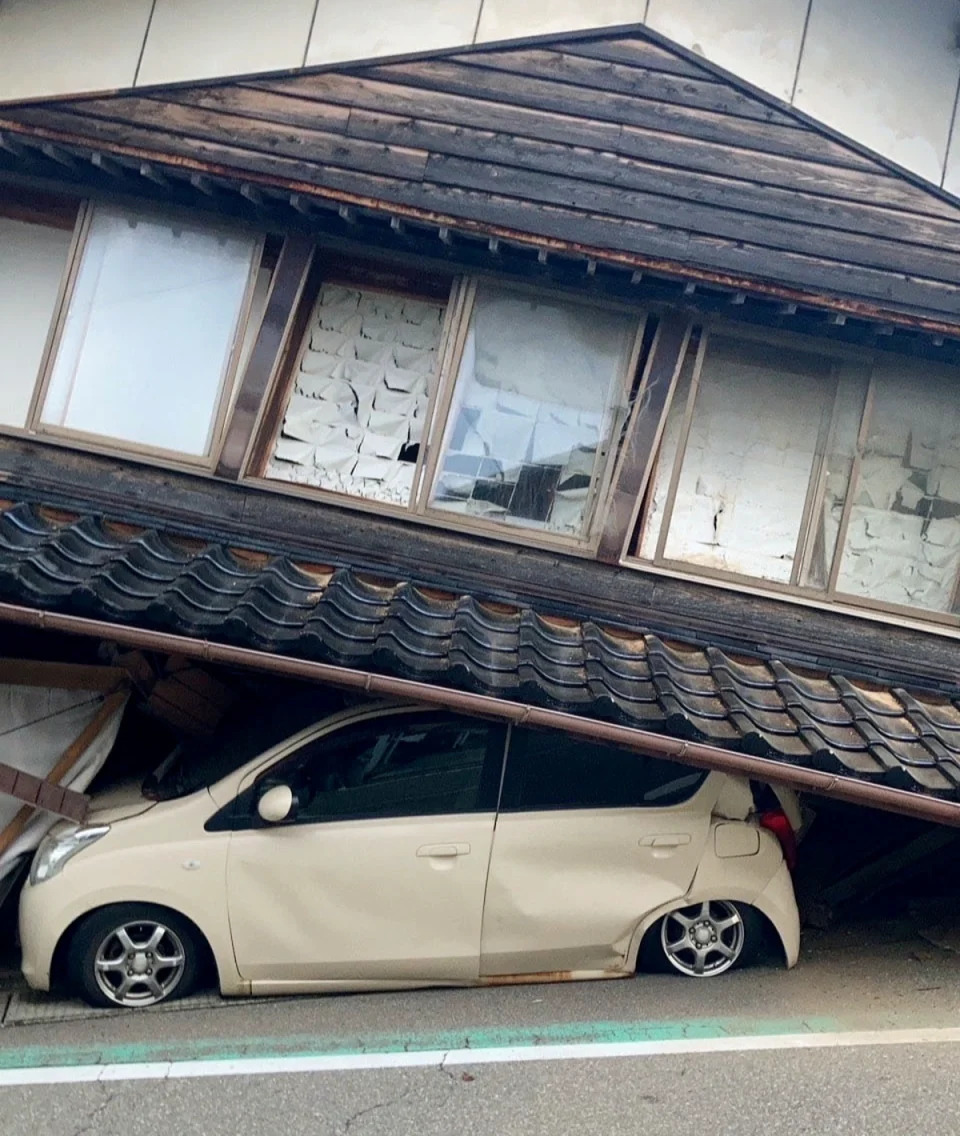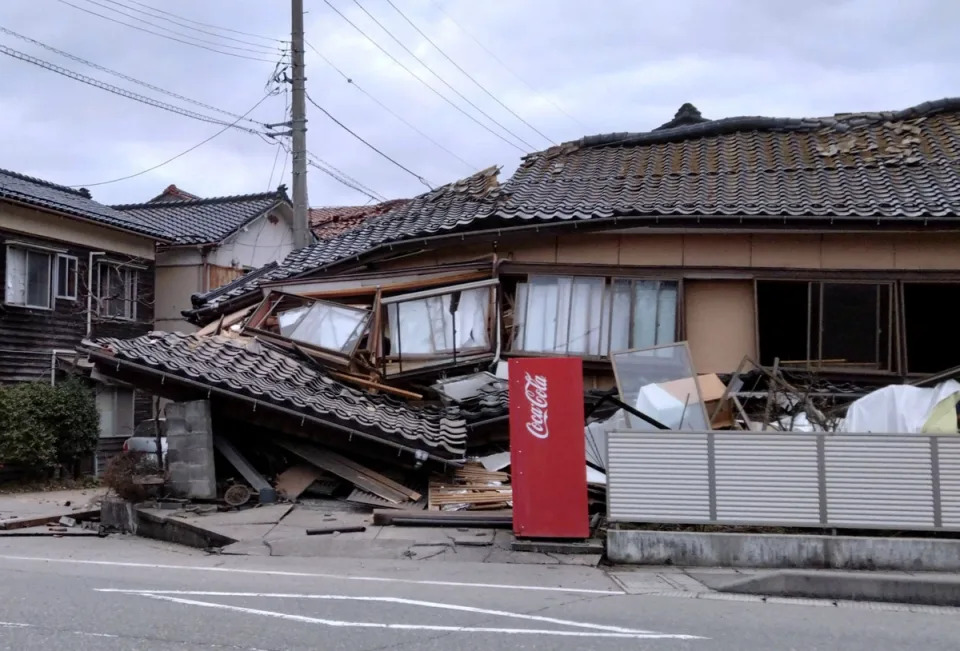UPDATED
Massive earthquake strikes Japan, triggering tsunami warningReuters
January 1, 2024

(AFP)
TOKYO (Reuters) — A massive earthquake with a preliminary magnitude of 7.6 hit central Japan on Monday, triggering a tsunami warning and advisories for residents to evacuate.
A tsunami around 1 meter high struck parts of the coast along the Sea of Japan with a larger wave expected, public broadcaster NHK reported.
The Japan Meteorological Agency has issued tsunami warnings for the coastal prefectures of Ishikawa, Niigata and Toyama.
Hokuriku Electric Power said it is checking for any irregularities at its nuclear power plants, NHK reported.
UPDATED
Japan earthquake: People trapped in rubble after buildings collapse
Josh Salisbury

A car is trapped under a collapsed house following an earthquake, in Shika town, Ishikawa prefecture, Japan (via REUTERS)
A spokesperson said no reports of deaths or injuries had been confirmed, but added the situation was still unclear.
The Japanese government has set up a special emergency center to gather information on the quakes and tsunami and relay them speedily to residents to ensure safety, Prime Minister Fumio Kishida told reporters.
Japanese news footage showed a crumbled house in Wajima city, Ishikawa Prefecture, and a search was underway to see if people were trapped in the rubble.
Bullet trains in the area were halted. Parts of the highway were also closed, and water pipes burst.
Japanese media reports showed a crowd of people, including a woman with a baby on her back, standing by huge cracks that had ripped through the pavement.
A tsunami nearly 10ft high (3m) was expected to hit Niigata and other prefectures on the western coast of Japan.
Smaller tsunami waves were already confirmed to have reached the coastline, according to NHK.

A collapsed house following an earthquake is seen in Ishikawa prefecture, Japan (via REUTERS)
In Kanazawa, a popular tourist destination in Ishikawa, images showed the remnants of a collapsed gate strewn at the entrance of a shrine as anxious worshippers looked on.
Kanazawa resident Ayako Daikai said she had evacuated to a nearby elementary school with her husband and two children soon after the earthquake hit. Classrooms, stairwells, hallways and the gymnasium were all packed with evacuees, she said.
"I also experienced the Great Hanshin Earthquake, so I thought it would be safest to evacuate," she said.
"We haven't decided when to return home yet."
The area includes a nuclear plant but government spokesman Yoshimasa Hayashi said: "It has been confirmed that there are no abnormalities at Shika nuclear power plant (in Ishikawa) and other stations as of now."
Meanwhile, Russia's emergencies ministry said that parts of the western coast Sakhalin island, situated close to Japan on Russia's Pacific seaboard, were under threat of tsunami.
The local population was being evacuated as a result, state news agency TASS reported on Monday.

People sit on the floor inside a store as an earthquake hits, in Kanazawa, Ishikawa, Japan (INSTAGRAM @HSU.TW via REUTERS)
In March 2011, a huge earthquake and tsunami struck northeastern Japan, killing nearly 20,000 people, devastating towns and triggering nuclear meltdowns in Fukushima.
South Korea also said the sea level in some parts of its east coast may rise between 18:29 to 19:17 local time (09:29 to 10:17 GMT) after the earthquake.
Josh Salisbury
Evening Standard
Mon, 1 January 2024

Japan has issued a tsunami warning after an earthquake with a preliminary magnitude of 7.6 hit the western coastline toward the centre of the country
An estimated 36,000 homes were left without power as the Japan Meteorological Agency issued a tsunami warning along western coastal regions of Ishikawa, Niigata and Toyama prefecture.
There are fears hundreds may be trapped in collapsed buildings.
A tsunami of up to three metres high is thought to be reaching Noto in Ishikawa Prefecture, according to the weather agency.
Officials on Monday afternoon downgraded the previous "major tsunami warning" for the region to a lower level "tsunami warning".
Waves more than 1 metre high hit the coast of Wajima City in Ishikawa Prefecture, NHK reported.
At least six homes were damaged by the quakes, with people trapped inside, government officials said.
Mon, 1 January 2024

Japan has issued a tsunami warning after an earthquake with a preliminary magnitude of 7.6 hit the western coastline toward the centre of the country
An estimated 36,000 homes were left without power as the Japan Meteorological Agency issued a tsunami warning along western coastal regions of Ishikawa, Niigata and Toyama prefecture.
There are fears hundreds may be trapped in collapsed buildings.
A tsunami of up to three metres high is thought to be reaching Noto in Ishikawa Prefecture, according to the weather agency.
Officials on Monday afternoon downgraded the previous "major tsunami warning" for the region to a lower level "tsunami warning".
Waves more than 1 metre high hit the coast of Wajima City in Ishikawa Prefecture, NHK reported.
At least six homes were damaged by the quakes, with people trapped inside, government officials said.

A car is trapped under a collapsed house following an earthquake, in Shika town, Ishikawa prefecture, Japan (via REUTERS)
A spokesperson said no reports of deaths or injuries had been confirmed, but added the situation was still unclear.
The Japanese government has set up a special emergency center to gather information on the quakes and tsunami and relay them speedily to residents to ensure safety, Prime Minister Fumio Kishida told reporters.
Japanese news footage showed a crumbled house in Wajima city, Ishikawa Prefecture, and a search was underway to see if people were trapped in the rubble.
Bullet trains in the area were halted. Parts of the highway were also closed, and water pipes burst.
Japanese media reports showed a crowd of people, including a woman with a baby on her back, standing by huge cracks that had ripped through the pavement.
A tsunami nearly 10ft high (3m) was expected to hit Niigata and other prefectures on the western coast of Japan.
Smaller tsunami waves were already confirmed to have reached the coastline, according to NHK.

A collapsed house following an earthquake is seen in Ishikawa prefecture, Japan (via REUTERS)
In Kanazawa, a popular tourist destination in Ishikawa, images showed the remnants of a collapsed gate strewn at the entrance of a shrine as anxious worshippers looked on.
Kanazawa resident Ayako Daikai said she had evacuated to a nearby elementary school with her husband and two children soon after the earthquake hit. Classrooms, stairwells, hallways and the gymnasium were all packed with evacuees, she said.
"I also experienced the Great Hanshin Earthquake, so I thought it would be safest to evacuate," she said.
"We haven't decided when to return home yet."
The area includes a nuclear plant but government spokesman Yoshimasa Hayashi said: "It has been confirmed that there are no abnormalities at Shika nuclear power plant (in Ishikawa) and other stations as of now."
Meanwhile, Russia's emergencies ministry said that parts of the western coast Sakhalin island, situated close to Japan on Russia's Pacific seaboard, were under threat of tsunami.
The local population was being evacuated as a result, state news agency TASS reported on Monday.

People sit on the floor inside a store as an earthquake hits, in Kanazawa, Ishikawa, Japan (INSTAGRAM @HSU.TW via REUTERS)
In March 2011, a huge earthquake and tsunami struck northeastern Japan, killing nearly 20,000 people, devastating towns and triggering nuclear meltdowns in Fukushima.
South Korea also said the sea level in some parts of its east coast may rise between 18:29 to 19:17 local time (09:29 to 10:17 GMT) after the earthquake.
Japan is bracing for a tsunami with waves as high as 10 feet after more than 20 earthquakes hit in just over 90 minutes
Marianne Guenot
Updated Mon, 1 January 2024

Road cracks caused by an earthquake are seen in Wajima, Ishikawa prefecture, Japan on January, 1, 2024.KYODO/Reuters
Japan issued tsunami alerts after a series of powerful earthquakes.
Quakes hit from 2 a.m. ET Monday off the coast of Ishikawa, one of them with a magnitude of 7.6.
Japanese officials warned torrents of water could reach as high as 10 feet.
Japan has issued tsunami warnings and evacuation orders after a series of powerful earthquakes hit the country overnight, destroying buildings and disrupting electricity and cellphone services.
Waves could reach up to about 10 feet (five meters), according to the Japanese Meteorological Agency, which urged people to flee to high land.
Japanese public broadcaster NHK TV had previously reported waves were expected to reach up to 16.5 feet (five meters), but the predictions have now been downgraded. Evacuation orders are still in effect, per NHK TV.
"We realize your home, your belongings are all precious to you, but your lives are important above everything else. Run to the highest ground possible," an NHK presenter said, according to the BBC.
It comes after the Japan Meteorological Agency reported 21 earthquakes registering 4.0 magnitude or stronger struck central Japan in just over 90 minutes on Monday. One of them had an estimated magnitude of 7.6.
Videos broadcast on Japanese TV appear to show cracks in roads, subway trains shaking and buildings collapsing.
The agency added there is a 10 to 20% chance more earthquakes of similar magnitude could hit within the next few days.

A map shows areas under tsunami warning as of January 1, 8:30 p.m. local time.
Marianne Guenot
Updated Mon, 1 January 2024

Road cracks caused by an earthquake are seen in Wajima, Ishikawa prefecture, Japan on January, 1, 2024.KYODO/Reuters
Japan issued tsunami alerts after a series of powerful earthquakes.
Quakes hit from 2 a.m. ET Monday off the coast of Ishikawa, one of them with a magnitude of 7.6.
Japanese officials warned torrents of water could reach as high as 10 feet.
Japan has issued tsunami warnings and evacuation orders after a series of powerful earthquakes hit the country overnight, destroying buildings and disrupting electricity and cellphone services.
Waves could reach up to about 10 feet (five meters), according to the Japanese Meteorological Agency, which urged people to flee to high land.
Japanese public broadcaster NHK TV had previously reported waves were expected to reach up to 16.5 feet (five meters), but the predictions have now been downgraded. Evacuation orders are still in effect, per NHK TV.
"We realize your home, your belongings are all precious to you, but your lives are important above everything else. Run to the highest ground possible," an NHK presenter said, according to the BBC.
It comes after the Japan Meteorological Agency reported 21 earthquakes registering 4.0 magnitude or stronger struck central Japan in just over 90 minutes on Monday. One of them had an estimated magnitude of 7.6.
Videos broadcast on Japanese TV appear to show cracks in roads, subway trains shaking and buildings collapsing.
The agency added there is a 10 to 20% chance more earthquakes of similar magnitude could hit within the next few days.

A map shows areas under tsunami warning as of January 1, 8:30 p.m. local time.
Japanese Meteorological Agency
Japan has a history of devastating tsunamis. A tsunami that hit Japan in 2011 following a 9.0 magnitude earthquake caused the Fukushima Daiichi nuclear disaster and the death of more than 18,000 people.
Waves during that tsunami reached heights up to almost 130 feet.
Government spokesman Yoshimasa Hayashi said that nuclear plants in the area had not yet reported any problems. He added that it was critical for people in coastal areas to get away from the oncoming tsunami.
"Every minute counts. Please evacuate to a safe area immediately," he said.
The city of Wajima in Ishikawa prefecture has already reported tsunami waves of almost four feet, according to NHK. Toyama prefecture, and Kashiwazaki, Niigata prefecture, also reported smaller tsunami waves.
Warnings of waves up to a meter three feet high were also issued for parts of North Korea and Russia. Russian officials issued a tsunami alert for the island of Sakhalin.
Officials of Ishikawa Prefecture's Suzu City have confirmed that several houses and power poles have been brought down by a local earthquake, which registered at 7.4 in magnitude, per NKH TV.

A tsunami warning is shown on TV in Yokohama, near Tokyo Monday, January 1, 2024
Japan has a history of devastating tsunamis. A tsunami that hit Japan in 2011 following a 9.0 magnitude earthquake caused the Fukushima Daiichi nuclear disaster and the death of more than 18,000 people.
Waves during that tsunami reached heights up to almost 130 feet.
Government spokesman Yoshimasa Hayashi said that nuclear plants in the area had not yet reported any problems. He added that it was critical for people in coastal areas to get away from the oncoming tsunami.
"Every minute counts. Please evacuate to a safe area immediately," he said.
The city of Wajima in Ishikawa prefecture has already reported tsunami waves of almost four feet, according to NHK. Toyama prefecture, and Kashiwazaki, Niigata prefecture, also reported smaller tsunami waves.
Warnings of waves up to a meter three feet high were also issued for parts of North Korea and Russia. Russian officials issued a tsunami alert for the island of Sakhalin.
Officials of Ishikawa Prefecture's Suzu City have confirmed that several houses and power poles have been brought down by a local earthquake, which registered at 7.4 in magnitude, per NKH TV.

A tsunami warning is shown on TV in Yokohama, near Tokyo Monday, January 1, 2024
Eugene Hoshiko
Around 33,000 households are without power with temperatures forecast to drop to 33 degrees Fahrenheit, NKH TV reported.
Six people are thought to be stuck under rubble in collapsed houses on the Noto Peninsula, and no information has been released on their condition, per The Guardian. Multiple people were also reported to be trapped in collapsed houses in Suzu, Ishikawa, per NHK TV.
Meanwhile, a fire has broken out in Wajima City, per The Guardian.
Small tsunami waves are common and cause little damage, but any waves with runups over one meter (3.28 feet) can be particularly dangerous to people living near coastal areas, per the US National Oceanic and Atmospheric Administration website.
The force of the waves themselves can cause substantial damage, but tsunamis are also dangerous because they cause flooding, erosion, and strong currents that can drag people out to sea. They can also bring in floating debris like trees and cars, that can act like battering rams, per NOAA.
The Japan Meteorological Agency had previously issued a "major tsunami warning" for Noto, Ishikawa Prefecture, warning of waves as high as 16 feet. This has since been downgraded to a "tsunami warning."
Update January 1, 2023: The story has been updated to reflect the latest advisory from the Japanese Meteorological Agency. Tsunami waves are now expected to hit 10 feet (3 meters) in height, rather than 16 feet.
Around 33,000 households are without power with temperatures forecast to drop to 33 degrees Fahrenheit, NKH TV reported.
Six people are thought to be stuck under rubble in collapsed houses on the Noto Peninsula, and no information has been released on their condition, per The Guardian. Multiple people were also reported to be trapped in collapsed houses in Suzu, Ishikawa, per NHK TV.
Meanwhile, a fire has broken out in Wajima City, per The Guardian.
Small tsunami waves are common and cause little damage, but any waves with runups over one meter (3.28 feet) can be particularly dangerous to people living near coastal areas, per the US National Oceanic and Atmospheric Administration website.
The force of the waves themselves can cause substantial damage, but tsunamis are also dangerous because they cause flooding, erosion, and strong currents that can drag people out to sea. They can also bring in floating debris like trees and cars, that can act like battering rams, per NOAA.
The Japan Meteorological Agency had previously issued a "major tsunami warning" for Noto, Ishikawa Prefecture, warning of waves as high as 16 feet. This has since been downgraded to a "tsunami warning."
Update January 1, 2023: The story has been updated to reflect the latest advisory from the Japanese Meteorological Agency. Tsunami waves are now expected to hit 10 feet (3 meters) in height, rather than 16 feet.
No comments:
Post a Comment